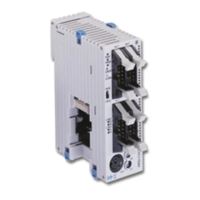FPΣ User's Manual
8.1 Communication Modes
155
8.1.2 Ports: Names and Principle Applications
The TOOL port is provided as a standard feature of the FPΣ. The ports on the communication
cassette are treated as COM port 1 and COM port 2. The principle applications of the various
ports are described below.
Port name Availability Communication mode
TOOL port Standard equipment (mini DIN 5-pin connector)
• MEWTOCOL-COM Slave
1)
• Program controlled (in RUN mode only)
2)
COM port 1
Only on optional communication cassette
• MEWTOCOL-COM Master/Slave
• Program controlled
• PLC Link
• Modbus RTU Master/Slave
COM port 2 Only on optional communication cassette
• MEWTOCOL-COM Master/Slave
• Program controlled
• Modbus RTU Master/Slave
1)
The master function cannot be used with the TOOL port.
2)
In PROG mode, the TOOL port is automatically set to MEWTOCOL-COM mode even if program controlled
mode has been selected. This way it is always possible to communicate in PROG mode with a programming
software like FPWIN Pro.
8.1.3 MEWTOCOL-COM Master/Slave
This communication mode uses the proprietary MEWTOCOL-COM protocol to exchange data
between a master and one or more slaves. This is called 1:1 or 1:N communication. A 1:N
network is also known as a C-NET.
MEWTOCOL-COM connection between a computer and the FPΣ
1
Command message
2
Response message
There is a MEWTOCOL-COM master function and a MEWTOCOL-COM slave function. The
side that issues commands is called master. The slave receives the commands, executes the
process and sends back responses. The slave answers automatically to the commands
received from the master, so no program is necessary on the slave.
REFERENCE
For detailed information on the MEWTOCOL-COM communication mode, see
"
MEWTOCOL-COM" on page 171.

